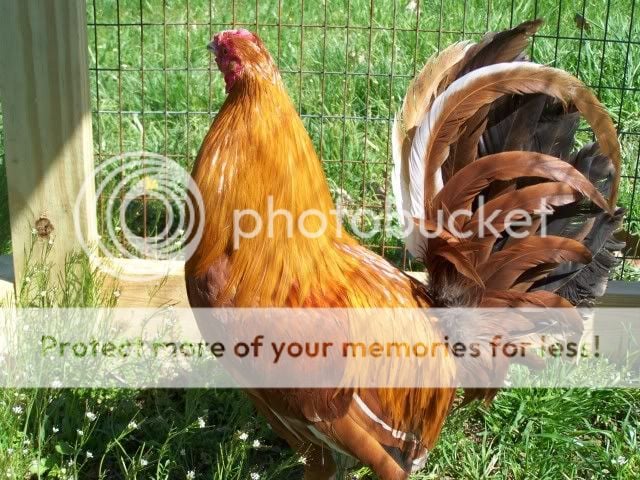Yes, Red Quill is Red, but Red Quill frequently carries ig cream, and this may be the gene behind the Cream segregates in the Pumpkin line. The original cross for Pumpkin, according to what history I have read was Red Quill and Wheaten. That means that they may carry cream from the Red Quill side, and that may account for the light colored segregates coming from Pumpkin matings. TShelton54
Navigation
Install the app
How to install the app on iOS
Follow along with the video below to see how to install our site as a web app on your home screen.
Note: This feature may not be available in some browsers.
More options
You are using an out of date browser. It may not display this or other websites correctly.
You should upgrade or use an alternative browser.
You should upgrade or use an alternative browser.
Pumpkin Hulsey Color Genetics?
- Thread starter Rootball
- Start date
have you seen a cream Red quill? I have not..! this means no ig cream in them, because even if ig is recessive, it still is bound by the genetic rules of segregationYes, Red Quill is Red, but Red Quill frequently carries ig cream, and this may be the gene behind the Cream segregates in the Pumpkin line. TShelton54
- Sep 1, 2010
- 131
- 16
- 126
So, what is going on with the Pumpkin Hulseys in the tail? This rusty orange to bronze color is a diluted black rather than a true red such as the light brown/red of the red jungle fowl hackles/?
Even though my original objective was replicating the Pumpkin Hulsey in an American Game Bantam, I've really taken to the Red Quills and, since they've been accepted in OEGBs, there's actually a shot at getting them accepted as an AGB at some point. Pumpkin Hulseys, on the other hand, are so heterogenus, with all of these various dilution genes that are apparently at work in the Pumpkin Hulseys, how could you ever nail that down?
But the part I'm interested in really is the bronze tail. It seems to show up occasionally in the Red Quills, but it almost seems as if it's the saddle color accidentally gets pulled into the tail.
Interestingly, I was reading my ABA standard and bronze in the tail is considered a fault. I guess there are always exceptions for specific varieties of specific breeds. If I could, I'd really like to get a reliably bronze tail in my lines.
Even though my original objective was replicating the Pumpkin Hulsey in an American Game Bantam, I've really taken to the Red Quills and, since they've been accepted in OEGBs, there's actually a shot at getting them accepted as an AGB at some point. Pumpkin Hulseys, on the other hand, are so heterogenus, with all of these various dilution genes that are apparently at work in the Pumpkin Hulseys, how could you ever nail that down?
But the part I'm interested in really is the bronze tail. It seems to show up occasionally in the Red Quills, but it almost seems as if it's the saddle color accidentally gets pulled into the tail.
Interestingly, I was reading my ABA standard and bronze in the tail is considered a fault. I guess there are always exceptions for specific varieties of specific breeds. If I could, I'd really like to get a reliably bronze tail in my lines.
the colored tails are due to unknown tail restrictors(or the combination of many restrictors like Co,Db,Mh and Di working together) its not diluted blackSo, what is going on with the Pumpkin Hulseys in the tail? This rusty orange to bronze color is a diluted black rather than a true red such as the light brown/red of the red jungle fowl hackles/?
or wheaten 

Yeah...No.or wheaten
I will only conceed if you can showme a breed of chickens that are Db and eWh only(with one or two more genes not related to pheomelanin restriction), and ofcourse no buff or pumpkin birds...
What color is this yellow with white wings..... beautiful!
- Sep 1, 2010
- 131
- 16
- 126
Well, there are multiple dilution genes working on PHs, some effect the red pigments, some the black. Getting a classic PH probably depends on having several of these all in the heterozygous state (just like the blue genetics). If you ended up with the red dilution genes in the heterozygous state but had the black dilution (dun?) in a homozygous state (splash like) you might get a bird like this one.
No, this is a classic hencolored wheaten.
- Sep 1, 2010
- 131
- 16
- 126
No doubt it has wheaten at the i locus as wheaten is essential to the PH, but I sure wouldn't call that "classic wheaten".
New posts New threads Active threads
-
Latest threads
-
Lethargic ducklings dying!
- Started by SoggyForks
- Replies: 0
-
-
-
-
ISO Dark Brahma Rooster, Im located in NE Florida
- Started by LionHeart1107
- Replies: 0
-
-
Threads with more replies in the last 15 days
-
-
-
-
Vent gleet/prolapse/abscess? What am I missing
- Started by FreshObsessed
- Replies: 47
-
-
×



